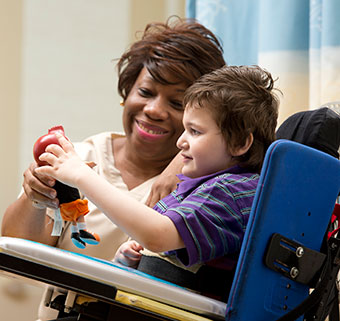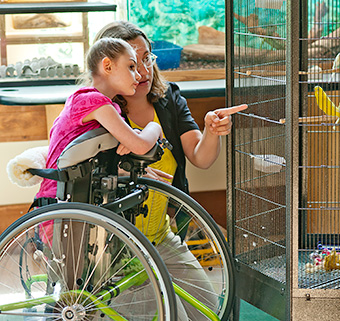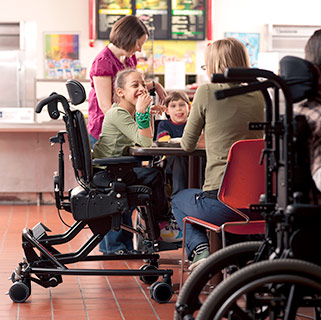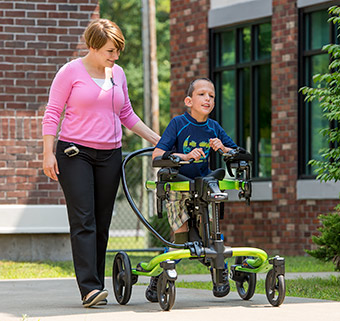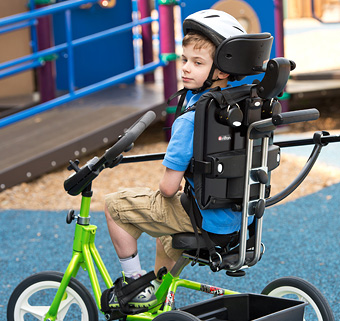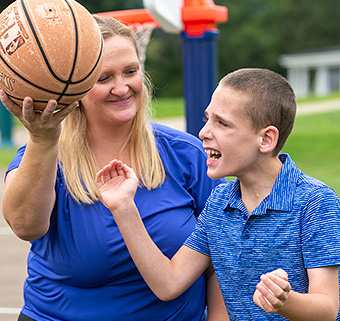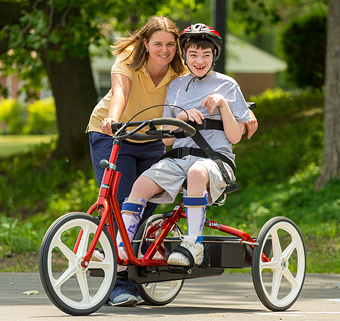Get Active, Get Ahead
Lori Potts, PT shares inspirations and ideas towards creating inclusive environments and effective functional fitness initiatives for children in adaptive equipment, to promote better health and quality of life.
Welcome
Welcome to this workshop. My name is Lori Potts. I am a physical therapist and senior product and training specialist with Rifton. Today we’ll be talking about children with physical disabilities using adaptive equipment, to be upright and active for inclusion in physical education.
So in this workshop, we’ll take a look at how three adaptive products can be incorporated into physical education activities for these children. Doing this will promote their ability to sit, stand and walk; because without this, their physical health can deteriorate. They miss out on the inclusion, the participation and the overall well-being that is there for them.
Adaptive Tricycle
Let’s start with the tricycle. This is a published journal article from 2019, a systematic review, and it summarizes research with adaptive tricycles. They concluded that for children with cerebral palsy, triking can improve muscle strength, balance and their gross motor function.
So we’re going to take a few minutes now to look at the features of the Rifton Tricycle. This tricycle is designed intentionally for children with significant physical disabilities. Notice how the pedals are placed so that the individual’s extensor tone helps to propel the tricycle; and notice how the forward motion of the tricycle results in that valuable range of motion for the individual, even if they do not have the muscle strength to self-propel. This handle at the back can allow for another student or a sibling who is ambulatory to hold on to this and help move the tricycle forward. There is a low transfer step to help with easier transitioning onto the seat. The loop handlebars easily swing up out of the way, and they can be set at the height and angle best suited for the individual. You have an option for a wide seat for sitting stability. And the trunk support is retrofittable to all Rifton Tricycles that are still in use out in the field. The advantage of this trunk support is that children who may be wheelchair dependent have the opportunity to be fully supported in the tricycle. Those who do not need the trunk laterals and butterfly harness don’t need to use them, but it expands that possibility of tricycling to many more users. You can even add a head support. This rear steering bar can be retrofitted to all Rifton Tricycles, regardless of which style of backrest or trunk support you may have. And now Rifton offers a stationary stand for encouraging pedaling even on a rainy day.
So it’s important to realize that the tricycle benefits not only the leg strength but also that ability to sit, with the improved strength of the back. Because it’s so motivating for the child to use the tricycle, they get that therapeutic benefit while having a fun time. This next video clip shows how a boy in Australia improved his leg strength and his posture stability by using his tricycle; and he improved not only his walking ability but even gained the ability to run.
…
With a tricycle, your imagination is the limit for use. It can serve as a transportation device rather than the wheelchair, for that value of the leg range of motion. Or you or the child’s family might set up an obstacle course in a parking lot or a gym. You could use blacktop chalk or cones or flags, or place tape on the floor in the gym. Do you know the game of I spy? During your outdoor walk or your indoor walk with a tricycle, you would tailor the description of the object to be guessed to the trike rider’s level, and they would look for the object and make their guess as they try to come along. For a child who would otherwise be in a wheelchair, the tricycle may allow them to participate in a 50 meter walk, with peers or siblings assisting. Or you could place one child on the tricycle when the gym class is doing laps, as the warm-up before beginning the PE activity.
Equal Opportunities
If we think about inclusion, it’s really about acceptance, belonging and being part of the community. It’s that simple. We know we want to give all children the same opportunities and level the playing field. We’ll know we’re there when everyone views the person with disabilities as an individual with their own given name. Joe doesn’t want to be labeled as handicapped, disabled or physically challenged. He wants to be known as Joe. Joe has his own set of strengths and weaknesses, his likes and dislikes, just like any one of us. Joe thinks a periscope should come as standard equipment with every wheelchair. We don’t realize at what a social disadvantage simply being in a wheelchair places that person, while everyone else is interacting at eye level.
Mobile Stander
This product provides all the benefits of standing as with any stander, but with the added benefit of mobility, with the large wheels. It supports the individual in an upright posture, with adjustments to vary the amount of weight bearing; and it allows for peer interaction. The large wheels remove for better access to a table or a counter surface. This published journal article from 2013 is a systematic review that summarizes research with adaptive standers; and the researchers concluded that for children with cerebral palsy, the use of adaptive standers improves bone mineral density as well as hip stability, range of motion, and can even reduce spasticity. The interesting thing is that based on their research, they recommend that for most of the benefits to occur, the child needs to be in that supported, weight-bearing position for an hour or more. This does not have to be all at once, but a total of at least 60 minutes.
Let’s take a few minutes now to look at the features of the Mobile Stander. See how the step is low, near the floor, for better ease of transfer. And then we have the body support system that can be raised and lowered. The higher position is more supportive for a low-tone or weaker child. The seat pad has four straps that can be secured on any selected clasp from these four available along the side; and by lengthening the top straps and shortening the bottom straps, we can create the effect of a seat for a child who is non-weight-bearing, or perhaps even a double amputee. A second seat pad can optionally be placed along the child’s back; or this fleece can be used across the upper back or behind the neck as well, for a child with severe extensor tone. We can optionally remove the large wheels to get closer to a table or other surface. And at the front, we can place this mounting bar which allows us to secure a communication tray. Another option is to use forearm prompts for a child with poor head or upper trunk control, by them bracing or supporting their forearms. That can enable them to improve their neck and upper back strength over time. For a child with good knee extension strength, we may choose to place them in the reverse position for better access to play and activities.
Possibilities for Participation
So once the child is in an upright position, there are any number of possibilities for participation and inclusion. Think about setting up a high wedge for the bowling ball, and the child places their hand on the bowling ball and releases it to let it roll down the wedge to the floor. And on the floor you could set up balance beams forming the lanes, so that the ball hits the bowling pins. This next series of video clips is from the Special Olympics coaching guide, and the reference for this guide will be provided at the end of our presentation. You could imagine that same opportunity with the child being in the Mobile Stander.
…
Some activities can be done with a class in a circle. Think about where you place your instructional aides, and the more able-bodied children, or any other teachers – next to certain students who may need hand-over-hand assistance. There are lots of fun activities with a parachute. You can google “elementary parachute activities” for ideas. One involves placing a large light ball on top to bounce it off the parachute, with everyone working as a team. You can also pass rings around the circle and that can be a game; or you can do it to music with a rhythm. Or you could use a large air-filled ball, like a beach ball or a balloon, and allow for attempts at volleyball-type passing through the air between the students, along with that hand-to-hand passing. Here we see Mrs. Hope found that some of her best instructors were still in second grade. “Now you try it,” says the little friend. “What graduate course did you take to learn so much about teaching students with disabilities?” “Well I can introduce you to one of my professors.” In other words the children themselves, by peer example, can be the best friends, advocates and teachers. We immediately think of how challenging it is to have a population of mixed abilities in the same physical education class; but in time, certain students themselves become the best solution for support to other students.
Making use of the tray on the Mobile Stander allows the child to carry an object, while still using the large wheels to move. So whether a child is self-propelling or whether a friend helps them to move, that allows them to be at peer level. If the child in the Mobile Stander has sufficient grip strength, we can switch things up by having the child and a classmate hold opposite sides of a hula hoop – and then the one child pulls the other child along in the Mobile Stander across the floor. For the beanbag toss, if the child doesn’t have the grasp and release skill, perhaps you can set the bean bag on the tray – and the child pushes it off the tray to land in a hula hoop target which is placed on the floor. Almost any physical education activity can be modified in some way to enable participation from a Mobile Stander. Working on grasp and release, you can use a ball and a Velcro wall, and allow the child to just place the ball right on the wall without throwing it. Or for corn hole, think about modifying the shape and size or the weight of the object the child will throw. Plan that distance and the size of the hole to guarantee success. You could contrast the colors on the target to help the child aim.
For more hand exercise, first crumple a piece of paper and then throw the scrumpled-up ball. We can suspend a balloon or a ball from the air so the child has to move it, and then attempts to stop the movement by catching it. We can have a child aim a ring onto a cone or a pull stand. Maybe again, first simply pushing the ring off the edge of a table with a target placed nearby. Or for a ball shoot, you could place one end of one of those flexible corrugated pipes near the child, and the child reaches out and drops a ping-pong ball into one end; and after doing several, they may go to the other end and retrieve them for the next round. Think about a table height surface. A large ball placed on a ping-pong table height can allow one child to push the ball, rolling it back and forth to another child across the table. And we can challenge the child to reach sideways by turning them so they are positioned sideways relative to the table, and make that reach. For a more able child, depending on the ball you choose, you can maybe set up a low barrier on the table; and then the ball is bounced back and forth over the barrier. An oversized racquet can be used for hitting it. And let’s imagine at home, for a child who has limited grasp and release, you might fill a Ziploc bag with air; and the child holds a hair dryer and uses that to blow the bag across the table.
Lots of ideas. We want to allow the child to participate. And PE teachers have created fun mechanisms, even with PVC pipe, string and rubber bands, what have you – so that the child only needs to hit a bar, and then this bat or racquet is released to hit the ball. I’m going to show pictures and videos of these, but have to admit I do not have any specific instructions for how to create these. You’ll just have to take inspiration and apply your own skill set and see what you can do for your students. And just imagine the child standing in a Mobile Stander instead of sitting to accomplish the same thing.
…
I’ll just mention that in the volleyball video, you’ll notice how the student knows that the volleyball will travel far, so he wants the coach to back up farther on the opposite court to receive it.
…
Now imagine a big stack of foam blocks that this volleyball would catapult into. That could be motivating. So those were some pretty incredible contraptions, and they’re out there. The sky is the limit when it comes to PE teachers, I’m finding out. So PE teachers may also be in the position to offer ideas and suggestions to parents. Have you ever heard of throwing plastic eggs full of paint at a plastic tarp and watching them explode? There’s an idea. One simpler indoor idea is for the parent to tie a string from one piece of furniture across the room and secure the other end of the string to another, and then attach a folded paper airplane to it. And as the child moves the paper airplane along the string, they also move across the room.
Inclusive PE
Before we demonstrate the Pacer, we’d like to talk about three critical concepts for inclusive PE: planning, collaboration and safety. With good planning, we can avoid this scenario. After trying to fly by the seat of his pants, Fred learned that good teaching requires good planning. We all recognize the value of getting children up out of their wheelchairs. Standing and walking has tremendous social and health benefits; and PE is a great place to do it. Gaining knowledge about the equipment is crucial. That can be done with the student’s PT. Perhaps the student’s one-on-one classroom aide comes to PE class with the student, and we’ll make sure that they are familiar with the student’s equipment. So each student has a legal right to access public education, including PE. We can advocate to have the student support needs met. Don’t be afraid to be pushy; go to administration if you don’t have enough hands on hand. You can also have the child’s PT or OT attend the PE class. Getting in and out of the equipment takes time, and we don’t want that transfer to be a spectacle in front of the other children. So plan the timing of when and where the transfer happens. And depending on the student’s tolerance and their ability to stay up in the equipment – with planning we can arrange for the student to be placed in the equipment, perhaps in the classroom, and come to PE already in the equipment. So needless to say, the PE activity itself will take planning. For many children, simply being placed in an upright position is already effortful and work.
With creative ideas, though, we can add to the fun. Here’s one idea. With the student’s socks and footwear off, you can do sensory walks outdoors or indoors. That will bring weight-bearing step-taking to a whole new dimension. You can do it with surfaces under their feet, such as a tarp covered in shaving cream, as shown here. This was replicating skiing on snow. Other ideas might be AstroTurf, smooth flat pebbles, bubble wrap, grass, straw or even sand or dirt. Here’s another example of a field day activity. The photo is deliberately blurred so as not to release identities, but this is an adaptive switch set up to turn on a leaf blower – and that in turn blows off a section of swim noodle. I think that’s what that is. So this is the sport event of the javelin throw. Again, imagination is the limit to what you can do. One idea is a car wash where the child in the Pacer goes past a bubble machine, or even a fine water is sprayed onto the student’s hands on a hot day. And meanwhile, strips of sheet can be pulled back and forth over the student, or the student can move through them. Another example is musical instruments hung at various heights; and the child walks toward and reaches for them, and the sound they make is the motivator.
At Halloween, you can turn the lights off and hang various low lights or colored lights from the ceiling, and have different sounds in different corners, and test the bravery of the child as they navigate their way along. Competitive sports that involve moving across the court can be modified and a lot of fun. One example is placing an adaptive switch under the foot, and the child lightly taps this to set off a leaf blower that then blows the ball across the floor; or just push a hand button adapter switch to start the leaf blower. And it results in this loud noise, and the child lifts their head up and they get more active postural control. And it’s just a whole lot better than when they’re in the sitting position. In all of this we need to prioritize the safety of the student of course; so using yarn balls or a large lightweight ball, we can safely involve more students. One PE teacher made it a rule that every child on the team had to contact the ball before the team can score, so this heightened the involvement of every child on the team.
As a PT myself, I can assure you PTs love to collaborate. Here’s a message from a PT in a MOVE school in Georgia. “Getting kids out of chairs and into equipment for active participation in PE takes planning ahead, equipment knowledge, and enough staff to support one-on-one assistance but it is so worth it! Don’t be afraid to enlist the school PT’s assistance, we are usually looking for those kinds of opportunities!” One PE teacher told me that she meets with the PT about every student, and with this collaboration she gains so much knowledge. How does the equipment work? How does the student get in and out of the equipment? What are the specific skills that the student is working on? And then during PE she can work on those same skills that the PT and teachers are. She’ll set things up so the student will hit a switch on their right side, for example, or with his head. So ultimately whether we’re talking about range of motion or motor control or endurance or even self-feeding, or if it’s communication related – maybe it’s doing transfers for a bathroom as the goal – she knows that ultimately these are lifetime skills that will improve the student’s quality of life. Plus it’s fun to pick the therapist’s brains for ideas. An OT might set up a tabletop activity with flower pots and seeds for Mother’s Day. A speech therapist might give guidance on choice making, using visuals, especially for the non-verbal children; because giving students choice is big. Or have large words that are posted to reinforce the words of the week from the child’s classroom. Might be stop and go, or directional words like up, down, forward, backward.
And that brings us to safety. Don’t be afraid of the equipment. Adaptive equipment is intended to be used under the guidance of a healthcare professional. So the PTs are always happy to share their expertise. Of course safety is paramount. If we can’t do something safely, then don’t do it. We do feel a certain risk when we attempt to place a child into equipment, but on the other hand we can think about it this way: What is the risk of not going into the equipment – of never allowing or enabling the child to be upright and moving? That can have significant negative outcomes for their health and their well-being. So the child’s teacher and therapist will know what is a reasonable amount of time that you can expect the student to tolerate being upright. And some students may have a time limit for how long they can be in equipment. Maybe they have skin sensitivity issues. But others may be working on an IEP goal toward extending their tolerance for a longer time. So you can arrange for that PT or OT to come into your PE class, share their knowledge and help you out for a while. So there’s no need to get bent out of shape about teaching children with such a wide range of needs. Just be flexible.
Each PE class will offer its own unique combination of students with their challenges, the solutions you find. You find you may need to be creative in how you guarantee that there are enough hands on hand, because that is a key factor for safety. Think about who you can possibly bring in to join you. Even bus drivers have been known to participate. And, to reiterate, inviting the student’s therapist to schedule their session during PE at regular intervals, when you can gear your lesson to more able-bodied students, knowing that that one-on-one adult will provide the hand-over-hand assistance. Then you’re all set. There are MOVE trained schools where it’s pretty well established that for physical education class, all non-ambulatory students will be up in a Pacer, a Mobile Stander or a TRAM during PE, so we know it can be done. This published journal from 2018 is a systematic review that summarizes research on overground and treadmill gait training. And the research has concluded that for children with cerebral palsy, functional gait training can improve walking speed, walking endurance and gait-related gross motor function. So it’s so worth it.
Pacer Gait Trainer
We’ll take a few minutes now to look at the features of the Rifton Pacer. Here is the Rifton Pacer gait trainer, and you can see the dynamic upper frame with a standard base. So this is a modular system. We also offer a standard upper frame without any built-in movement. We have a utility or sport base with larger wheels for outdoor use. And a very important design development is this multi-position saddle, which allows you to adjust height as well as positioning, including the angle and the seat depth. This MPS is used in conjunction with the chest prompt and the arm prompts. An important feature to realize is that the Pacer frame can also be used in the reverse position. So should you decide to do this during your PE class, you may want to first take a picture, so you know exactly how the classroom teacher and therapist had it set up initially. So using the Pacer in the reverse position involves a very simple adjustment. To turn the MPS around, remove the hip corral, depress the seat depth lever and slide the seat off; then turn it and slide it back in the groove and into place. And once the child is seated on the MPS, you can then secure the hip corral and buckle that around them. This will also mean transferring the arm promtps to the open end of the frame as well as opening the chest prompts flaps, angling it as appropriate. And then the child has the freedom to participate in gym, kicking a ball.
Another consideration is that the casters have adjustments. You have a swivel lock, a forward-only ratchet, and a lever that increases resistance to slow the Pacer. The brakes can be used as well. All these features can impact the child’s performance.
Connect with Us
The Rifton website offers wonderful tutorials where you can learn more about these features and adjustments. This will close our workshop, and don’t hesitate to contact Rifton with any further questions you may have.
